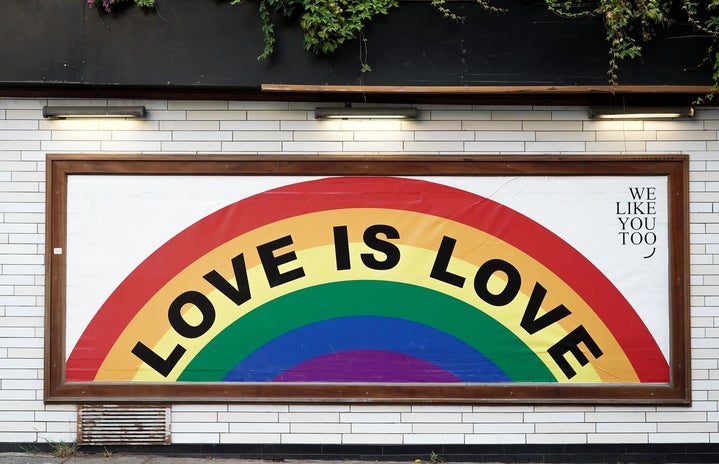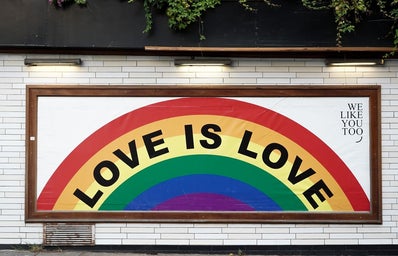Although there is a divergency in whether March 25 is called National Gay Pride Day or National LGBTQIA+ Pride Day in Brazil, the community still agrees that there’s a lot more to fight for before the country can say that LGBTQIA+ people have reached equal rights. It’s still important to celebrate March 25, and to acknowledge that, more than just on this specific date, the struggle for a better life is still happening every single day, and here are only a few reasons why:
- The representation of the community in the media is still based on stereotypes.
-
Luana Inêz, 22, identifies as a lesbian, and says that she feels like the media tells her that “she tries to be a man” and that she “must hate everything related to femininity”. The stereotypes that surround LGBTQIA+ media productions are still made for the straight public, usually by straight directors and screenwriters, and it reinforces these harmful patterns. Handria Thaime, 19, agrees with Inêz, mentioning a sentence that she listens to a lot, in reason of the lesbian stereotypes in media: “but you’re so feminine, you don’t even look like a lesbian”.
Those kind of assumptions on how a gay person looks like not only invalidates people who don’t conform to the norms dictated by media, but also makes the “journey” of coming out a lot harder. Victor Alves de Araujo, 26, says that the entire process of understanding yourself in Brazil it’s still far from being ideal. He studies the history of the LGBTQIA+ movement in the country, and affirms that, although Brazilians have come a long way, we’ve taken so many steps back since 2018.
- Every 19 hours, one LGBTQ+ person is killed in Brazil
-
Susana Santander, 48, is the mother of a 23 year-old lesbian, and an activist for the non-governmental organization “Mães pela Diversidade” (“Mothers for Diversity”, in English). She says that the leaders of the group were moms whose gay children were harassed, hurt, and even killed. There’s a division of the NGO for every state in Brazil, and it gets funds, resources and even free lawyers if an LGBTQIA+ person comes to their organization asking for help. The activist says that the existence of “Mães pela Diversidade” should be more recognized, because it is a thought country to live as an LGBT. And she’s, unfortunately, not wrong. According to a report released by “Grupo Gay da Bahia” (“Gay Group from Bahia”, in English), in 2019, 329 LGBTQIA+ people were violently killed in Brazil, and it is despairing that a group such as “Mães pela Diversidade” still needs to exist in 2021.
This data is directly reflected in media, and how media sees gay people. Bianca Santos, 22, lesbian, says that “most of the times, when you have a lesbian couple on TV, they never end up together, one of them always has to die”. This is shown as a hopeless situation for LGBTQIA+: it is inevitable, you are most likely going to get killed, or commit suicide. To be a person still figuring out who you are and only seeing these kinds of scenarios is horrifying, and it only makes people hide themselves even more.
- There are still LGBTQIA+ kids being harmed and kicked out of their homes by their own parents
-
The engagement consulting agency “Santo Caos” (“Holy Chaos”, in English), accounted that 63% of the LGBTQIA+ youth are partially or completely rejected by family members after coming out. Sometimes, the situation might get worse, with verbal and physical aggressions. Santander tells me, with pain in her voice, about the parents she’s seen neglecting their own gay children, with the main reason, for her, being religious beliefs and sexism.
The activist observes that, to her lesbian daughter, the only thing she needed was the acceptance of her parents, and that she was luck that they took her side and approved her. “I’m tired of seeing my colleagues, my daughter’s colleagues, being scared, developing depression […] because their families won’t accept them”, she says. Ana Laura de Azevedo, 19, was so scared to tell her homophobic dad that she was a lesbian that ended up developing depression, and forcing herself to be with guys – the infamous “compulsory heteronormativity”, or “comp het” for short, which is a problem that causes severe mental illnesses and delays the process of coming out to a great part of the LGBTQIA+ community.
Sabrina Larissa, 19, bisexual, also talks about how her family’s religion won’t let them accept her sexuality. “They just don’t understand religion the way I do” she says, while telling me about how she remains catholic, especially because the priest from her church embraced her and her sexual orientation. However, the girl recognizes that not all churches are the same, which is one of reasons why many LGBTQIA+ people step away from religion.
- The information about being LGBTQIA+ is still not easily accessed
-
Victor Alves is a History major in Universidade de São Paulo (USP) and partnered up with a professor to study the history of the LGBTQIA+ movement in Latin America and, specifically, in Brazil. He tells me that he decided to research this topic because there’s a lack of studies and researchers in this area. Education is a big deal for Alves, as well as making it accessible for everyone. He says that information about LGBTQIA+ rights should be available for a greater public. “There are the Congresses [discussing LGBTQIA+ issues] but I believe they’re not really accessible to everyone. It should be of common knowledge when it happens, what are the issues that are being discussed and when the decisions in the name of the community are to be made.”, he affirms.
The historian also tells me that LGBTQIA+ health should be taught in schools. Alves mentions the health of intersex kids, who are sometimes mutilated without their permission as soon as they’re born, and their intimate wellbeing is never addressed in sex-education classes. According to the Instituto Unibanco, the school silence reinforces inequality amongst kids. “In the case of LGBTQIA+ students, we need to overcome the standardized and homogenizing views that dictate that the ‘different’ must adapt to the rules and norms”. The Institute also stated that the greater victims of bullying in schools are, by far, the LGBTQIA+ kids.
“When you teach about intersexuality and transsexuality to the younger social level, you’re not only fighting against prejudice, but you’re ensuring thatthar people are familiar with the process of understanding themselves and the world in which they belong”, concludes Alves.
—————————————————————–
The article above was edited by Gabriela Sartorato.
Liked this type of content? Check Her Campus Casper Libero home page for more!



